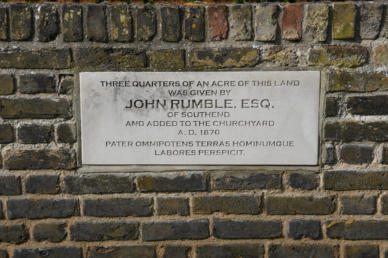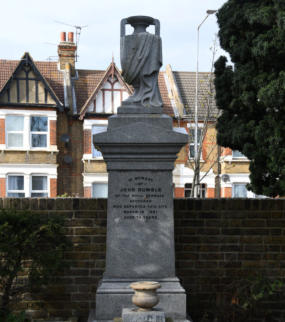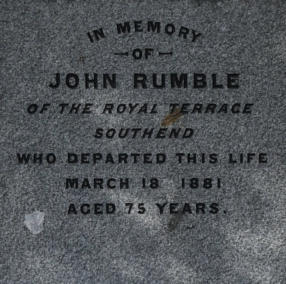John Rumble
John
Rumble
was
a
farmer
and
appears
to
have
been
involved
in
buying
and
managing
farmland,
but
does
not
appear
to
have
been
a
major
player
in
the
town’s
development.
Rumble
was
a
successful
farmer
when
most
income
was
derived
from
the
land,
he
would
have
been
part
of
a
network
of
landowners
(Scratton
for
example),
corn
merchants
(the
Luckings
and
Vandervords),
farmers
and
even
blacksmiths
who
all
depended
upon
each
other for income and so looked after each other's interests.
The
local
directories
in
the
mid-19th
century
describe
him
as
a
farmer
and
living
at
14
Royal
Terrace
with
his
wife
Charlotte.
He
was
born
in
Cliffe,
a
village
on
the
Hoo
peninsula
in
Kent.
Even
today,
the
area
consists
of
farmed
marshland
(with
a
nature
reserve)
and
any
experience
gained
there
would
have
served
him
well
in
farming
on
Foulness
and
in
Wakering
in
the
19th
century.
The
date
of
his
birth
is
not
recorded
but
his
various
ages
provided
for
census
returns
and
on
his
death
record
all
indicate
that
he
was
born in 1806.
John
Rumble
first
appears
in
Essex
Records
in
1830
where
he
is
described
as
a
farmer
of
Foulness
and
was
entering
into
a
partnership
with
William
Henry
King,
a
South
Shoebury
farmer,
regarding
West
Shelford
Farm
in
Foulness.
The
agreement
involved
Rumble
taking
upon
himself
the
entire
management
of
the
farm.
In
the
same
year,
Rumble
paid
for
a
valuation
of
Newick
Farm
on
Foulness
Island.
It
is
evident
that
he
was
either
considering purchasing the farm or already owned it.
The
1841
census
shows
John
Rumble
living
at
New
Wyck
(aka
Newick
Farm),
Foulness
with
his
wife
Charlotte
and
five
others.
Four
were
men
in
their
early
20s
and
therefore
likely to be farm workers. A woman in her early 30s was likely a domestic servant.
Ten
years
later,
the
1851
census
shows
that
John
Rumble
was
doing
well
for
himself.
He
was
then
living
at
14
Royal
Terrace,
Southend
with
his
wife
Charlotte
and
two
female,
domestic
servants
(aged
16
and
24).
He
was
then
described
as
being
in
occupation
of
300
acres and a labourer.
By
1855,
like
others
in
Southend
who
were
involved
in
either
property
dealings
or
law,
John
Rumble
also
had
a
London
business
address
(7
Delahay
Street
in
prestigious
Westminster).
In
that
year,
Rumble
purchased
Brays
Farm
(aka
Tyrell's
Farm),
a
47
acre
site
in
Great
Wakering
and
Little
Wakering.
The
farm
comprised
a
farmhouse,
then
divided
into
2
cottages,
a
homestead
with
barn,
bullock
house,
stable
and
cart
lodge,
and
arable
and
pasture
land.
Three
others
were
involved
in
the
purchase
James
Gardner,
Richard
Hall
and
Stephen
Allen.
Gardner
and
Hall
were
appointed
as
trustees
of
the
farm
in
the
agreement
so
it
appears
that
Rumble
was
a
silent
partner
in
the
farm,
providing
financial
backing
but
leaving
the
management
to
others.
The
farm
had
been
purchased
from
the
North
Shoebury
Estate
of
the
Welch
family
(who
had
previously
purchased
it
from the Tyrell family).
This
period
of
the
mid-19th
century
was
a
time
when
the
two
major
landowners
in
the
area,
the
Asser-Welch
and
Scratton
families)
were
beginning
to
sell
their
manorial
estates
and
tenant
farmers,
who
had
previously
leased
their
land,
were
able
to
buy
the
same
outright.
In
subsequent
descriptions
in
Essex
Records,
John
Rumble
was
no
longer
described
as
a
farmer
but
as
a
'gentleman',
meaning one who makes a living from ownership of land (rather than by working it).
In
1869,
Daniel
Robert
Scratton
sold
a
large
swathe
of
lands
of
his
Prittlewell
Priory
and
Milton
Hall
Estates
in
order
to
retire
to
Devon.
As
Scratton
realised,
this
period
would
be
one
of
transition
from
the
manorial
system
of
local
government
to
local
boards
that
would later become local councils.
The
sale
of
Scratton's
land
enabled
John
Rumble
to
purchase
the
freehold
to
the
property
that
he
occupied
at
14
Royal
terrace
for
£400
(April
1869).
Residents
of
Royal
terrace
had
previously
enjoyed
the
exclusive
use
of
the
Shrubbery,
a
private
garden
that
extended
down
the
cliffs
to
the
beach
on
the
west
side
of
Southend's
pier.
Scratton
saw
that
the
Shrubbery
had
been
neglected
over
the
years
and
wanted
to
preserve
it
so
that
it
could
become
a
space
to
be
enjoyed
by
the
public
in
what
would
become
a
rapidly
developing
town.
In
July
1869,
Scratton
set
up
a
Trust
to
maintain
the
Shrubbery
until
such
time
as
a
local
authority
could
take
over
its
management.
He
funded
the
trust
and
appointed
the
trustees.
Immediate
funds
were
provided
for
a
makeover
of
the
gardens
and
Essex
Records
hold
copies
of
invoices
for
wrought
iron
works
and
gardening
supplies
from
local
nurseries.
From
this
time,
the
Shrubbery
could
be
enjoyed
by
all
members
of
the
public
and
a
small
admission
fee
was
charged
to
contribute
towards
the
cost
of
maintaining
the
gardens.
John
Rumble,
a
resident
of
Royal
terrace
was
appointed
as
a
trustee
of
the
Shrubbery,
along
with
Daniel
Scratton
himself,
James
Scott
(owner
of
the
Royal
Hotel)
and
John
Page.
Thus,
in
1869,
we
see
John
Rumble
being
involved
in
public
service.
It
is
for
the
following
year
that
Essex
Records
first
reveal
John
Rumble's
involvement
with
St
John
the
Baptist's
Church.
The
Scratton
family
had
provided
the
land
on
which
the
church
had
been
built
to
open
in
1842.
The
church
then
served
a
parish
population
of
nearly
2,300
but
this
would
more
than
quadruple
by
1880.
Records
from
1870
show
that
St
John's
churchyard
had
been
extended
and
the
additional
land
was
consecrated
in
that
year.
Amongst
the
documents
are
records
of
a
court
case
heard
in
the
Chancery
between
John
Rumble
and
Elizabeth
Heygate.
In
the
same
1869
sale,
the
Heygate
family
had
purchased
their
previously
leased
land
from
Daniel
Robert
Scratton
and
this
included
the
land
surrounding
the
church.
There
was
evidently
a
dispute
regarding
the
land
to
be
consecrated
and
maps
were
produced
along
with
documents
relating
to
the
1869
sale
of
land.
The
documents
are
amongst
the
churchwardens
papers
and
it
must
be
assumed
that
John
Rumble
was
acting
as
churchwarden
at
the
time.
It
is
not
clear
what
stance
Elizabeth
Heygate
was
taking
as
defendant.
At
this
time,
the
churchyard
was
bounded
by
orchards
attached
to
Grovefield
House.
The
latter
was
owned
by
Elizabeth
Heygate
but
was
occupied
by
Rev.
William
Edward
Heygate,
the
vicar
of
St
John's
and
was
used
as
the
vicarage.
In
any
event, the consecration went ahead as a result of the court's ruling.
Elizabeth
Heygate
died
in
about
1876
and
the
Heygate
family
decided
to
sell
the
land
around
St
John's,
retaining
Porters
as
the
family
residence.
The
vendor
in
the
1880
sale
was
Revd
Thomas
Edmund
Heygate.
The
sale
of
land
enabled
the
development
of
the
area
including
York
Road
and
Heygate
Avenue
but
the
name
of
one
of
the
new
roads,
Chancellor
Road
(built
alongside
the
churchyard) appears to be a reference to the Chancellor's court where the legal judgement was obtained.
A
year
after
this
sale,
John
Rumble
died
at
home
in
Royal
Terrace
on
18th
March
1881.
He
was
buried
in
the
extended
section
of
St
John's
churchyard
with
Chancellor
Road
in
the
background
of
his
headstone.
By
1897,
the
fledgeling
Municipal
Borough
of
Southend-on-Sea had built a new graveyard and St John's churchyard was closed to further burials on the site.

Southend-on-Sea
John
Rumble’s
memorial
in
the
churchyard
of
St John the Baptist Southend
Southend Timeline Southend-on-Sea © 2009 - 2024. All Rights Reserved


Plaque
in
the
wall
of
the
churchyard
St
John
the
Baptist
Southend
Close
up
of
inscription
on
John
Rumble’s
memorial




SOUTHEND CITY

Southend-on-Sea’s No 1 History Website! Documenting The Town & The Townspeople
Now Incorporating The Sea Of Change Website
Website Info:


Chalkwell ▪ Eastwood ▪ Leigh-on-Sea ▪ Prittlewell ▪ Shoeburyness ▪ Southchurch ▪ Thorpe Bay ▪ Westcliff-on-Sea
































































